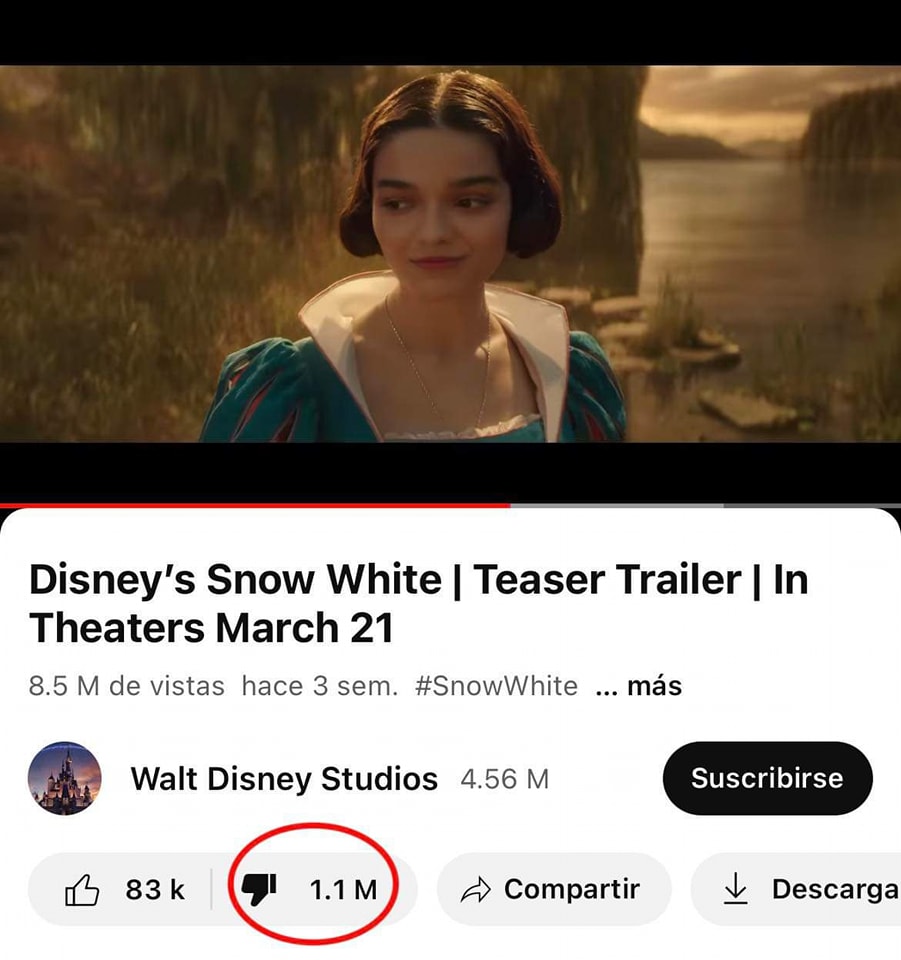Disney – Why children should not have to watch Disney’s creations part 3
Disney, once a bastion of family entertainment and a symbol of the wonder of childhood, is facing challenges non-stop. Its latest production, the adaptation of Snow White, was mired in controversy—focused not only on the creative choices of the film, but also on the public persona of its lead actors.
Role of public figures: disengagement through engagement
The lead actress of the new Disney’s Snow White, Rachel Zegler, has attracted significant attention for her open political activism. While freedom of speech is the cornerstone of a democratic society, public figures in the entertainment industry have a real impact, often blurring the lines between art and activism. Zegler’s political views – including her vocal support for Vice President Kamala Harris and alleged inflammatory remarks following the 2024 election results. – they polarized the public (the comedian called for aggression and expressed her desire to make Trump voters’ lives miserable).
The public’s trust in entertainers often depends on a perceived balance of power; when this trust is seen to be broken, it reflects on the institutions they represent. For Disney, a company synonymous with wholesome brand-whoring, Zegler’s narcissistic polarizing presence further aggravated the reaction. Her language—which some interpret as advocating violence—has disheartened parts of the public, especially those who prioritize traditional values or feel targeted by her rhetoric.
Disney’s shift towards “wokeness”
Disney’s embrace of progressive ideologies—often referred to as “woke”—has become a target for criticism. The term itself has evolved to describe an overemphasis on social justice at the expense of universal connectivity. In Snjeguljica, the decision to rethink key elements of the original story, such as the exclusion of the legendary patuljak in favor of “magical beasts” and a departure from traditional storytelling, reflect a broader trend in Disney’s recent productions.
This change has led to the perception that Disney prioritizes ideological messages over quality storytelling. The public has long embraced Disney for its timeless stories, rich emotions and cultural significance. When they are replaced by open political or social commentary, the effect of disbelief is reversed. Viewers feel less like they are being entertained and more like they are being lectured – a dynamic that leads to resentment and disengagement.
Psychological impact of polarization
Disney’s current trend emphasizes the psychological impact of cultural polarization. Narratives are the basis of human experience; they serve as a mirror that reflects our shared humanity. When narratives are weaponized to serve a plan of destruction, they lose their capacity for unity. This phenomenon creates a backlash: part of the public is diverted by the fact that third parties are using the creators to promote their ideological positions, which additionally depresses viewers.
The controversy surrounding Snow White overshadows this cycle. The reimagining of Snow White as an independent, feminist figure resembling romantic desires appeases an audience that values the simplicity and romanticism of the original story. This reimagining is not inherently problematic, but it becomes controversial when it is understood as a rejection of past values in favor of a contemporary ideology.
The isolation of Disney’s tale of awakening
Reaction to Disney’s “troubled” tale can be seen as a reaction to the loss of neutrality in cultural institutions. Entertainment, especially for children, through history has been a refuge from social disagreements. By reconciling its stories with ideologies that incite violence, Disney has violated an unspoken social agreement: the promise that it will provide an escape from reality and joy.
Furthermore, open-mindedness often lacks nuance, reducing complex social issues to binary images of good and evil. This oversimplification disconcerts not only the conservative public, but also reasonable people who want a balanced discourse. It reinforces stereotypes, deepens social divisions and risks judging Disney’s legacy on the telling observation of the dangers of giving priority to ideology over artistry.
Disney’s current battle with Snjeguljica and its wide-ranging creative strategy reveal the risks of allowing ideological fervor to overshadow storytelling. Although progress and representation are vital, they must strive for a world of public expectations and devotion to artistic integrity.
The response is not just about politics; it reflects a double guilt for the evidence that unites, not divides. If Disney is to reclaim its place as a cornerstone of culture, it must reopen the universal appeal that made it a household name. This includes creating a narrative that honors tradition while confidently embracing change – stories that uplift, inspire and remind us of our shared humanity. Only then can Disney emerge from the shadow of its controversies and reestablish itself as a beacon of joy.
Other examples of Disney’s “Woke” program and their toxic implications
Disney’s embrace of the “probuđenje” culture has sparked controversy over Snow White, in light of several recent productions and corporate decisions. This trend has led to a broad debate about the use of entertainment in promoting social programs and the subjective satisfaction of the general public. In the continuation, we examine significant examples and why these behaviors have proven divisive and, in some cases, toxic for the Disney brand and public perception.
Emotional avoidance – Healing Means Learning to Sit with Discomfort
Case Study 1: The Little Mermaid (2023)
Disney’s remake of The Little Mermaid has sparked significant controversy over the casting decision and the alteration of the original story. Although the decision to cast Halle Bailey as Ariel has been praised for its inclusivity, it has also sparked a backlash which is not maliciously rooted in racism, but rather in the perception that Disney has given priority to diversity over the continuity of storytelling or artistic values.
Except for the choice of actor, changes in the themes of the film – such as the Arieline’s frustration at the lack of a romantic relationship, which is focused on her language inattention – have shifted the fundamental message of the narrative. Critics have argued that this approach has alienated fans of the original story, which emphasized themes of love, sacrifice and self-discovery.
This kind of “troubled” revisionism sends a polarizing message: that traditional themes, even when loved, are somehow outdated or inferior. Instead of unifying the audience, such changes divide it, with some viewers feeling that their values or cherished childhood experiences are being erased.
Case study 2: Lightyear (2022)
Pixar’s Lightyear, a spin-off of the Toy Story franchise, received a significant backlash for including a gay character. While media scrutiny is important, the handling of this scene became the focal point of the debate. Many viewers felt that the censorship was less about improving the story and more about making a political statement, especially as Disney publicly opposed the Florida “Don’t Say Gay” law during the same period.
The controversy resulted in the film being banned in several countries and a loss of revenue. The general public, which includes families seeking neutral entertainment, experienced the scene as an ideological indoctrination rather than a natural part of the story.
By politicizing its narrative, Disney risked alienating its traditional base, and at the same time failed to satisfy progressive advocates who saw this move as symbolic. This missed opportunity has resulted in a challenge to address social issues without polarizing the public.
Case Study 3: Strange World (2022)
Disney’s Strange World broke new ground by including an openly gay young protagonist, but its execution revealed critical flaws. The film performed poorly at the box office, which is attributed to a lack of marketing, and the audience felt that the inclusion of sexuality was more performative than meaningful.
Critics have argued that Disney’s focus on meeting the diversity quota has come at the expense of creating believable, universal stories. This highlights a recurring problem in recent Disney content: prioritizing the message over the quality of the storytelling. When representation becomes forced rather than organic, it risks alienating the audience it wants to represent and the wider viewing public.
Why these behaviors are toxic
Disengagement of the general public
Disney’s historical success lies in its ability to create a narrative that transcends time, culture and politics. By promoting ideological messages that challenge society in its films, the company risks alienating its wide and diverse audience, especially families who see Disney videos as a safe, apolitical space for their children.
Erosion of artistic integrity
A great story relies on authenticity and connectedness. When narratives become the bearers of a plan, they often lose the emotional resonance and universality that make them appealing. This shift undermines faith in Disney as a storyteller and draws attention to its work in the battlefield of cultural disputes.
Suspected unsustainability
Disney’s recent decisions are often perceived as unsustainable in terms of traditional values and the public. By reworking beloved stories to fit a modern ideology, the company implicitly suggests that previous values or interpretations are outdated or inferior. This creates resentment and a sense of cultural inferiority.
Polarization and division
Instead of inclusiveness, Disney’s approach has in many cases exacerbated social divisions. A negative representation can be seen as segregation, not as meaningful inclusion, leading to a reaction from all sides. As a result, Disney is increasingly becoming a symbol of polarization rather than unity.
Economic consequences
The public’s reaction has translated into significant economic consequences. Films such as Light Year and Wonder World had poorer results on the box office, while the growth in the number of subscribers to Disney+ slowed, causing concern among executives about the long-term sustainability of the business. The public is speaking out to its fans, signaling its dissatisfaction with Disney’s direction.
The need for balance
Disney’s focus on representation and inclusivity is commendable, but its execution has often been counterproductive. True representation should improve the narrative, not obscure it. Successful integration of different perspectives requires inclusivity, respect for original material and a focus on universal themes that resonate across all demographics.
The toxicity of Disney’s “tried and tested” agenda lies in its failure to establish this balance. Instead of uniting audiences through shared values and experiences, it often prioritizes ideology over art. If Disney is to recover, it must return to its roots: the creation of timeless, magical stories that uplift and inspire all viewers, regardless of background or beliefs.

Keywords: disney, critics, wake, somatic experiencing therapy, psychotherapist zagreb, gestal therapy, Licensed therapist near me in Manhattan NYC, Affordable therapy services in New York State, Holistic psychotherapy sessions in NYC, Somatic Experiencing therapy for trauma recovery in New York City, NARM therapy in Brooklyn, Licensed couples therapy in Manhattan, Gestalt therapy near me in NYC, Marriage counseling in Queens NYC, Therapy for anxiety treatment in NYC, Experienced psychotherapist in New York, Licensed psychotherapist near me in NYC, Somatic Experiencing therapy sessions in New York, Trauma therapy and counseling in Manhattan, Gestalt therapy sessions in New York City, Therapy sessions for emotional regulation in New York, Trauma therapy near me in Brooklyn New York, Licensed mental health therapist in Manhattan NYC, Depression therapy in New York, New York City therapist experienced in PTSD treatment
*Photo: GettyImages
*Contact: Dogovori termin
*For companies: https://creativemanager.eu
You Were Not Loved Less, You Were Loved Conditionally








